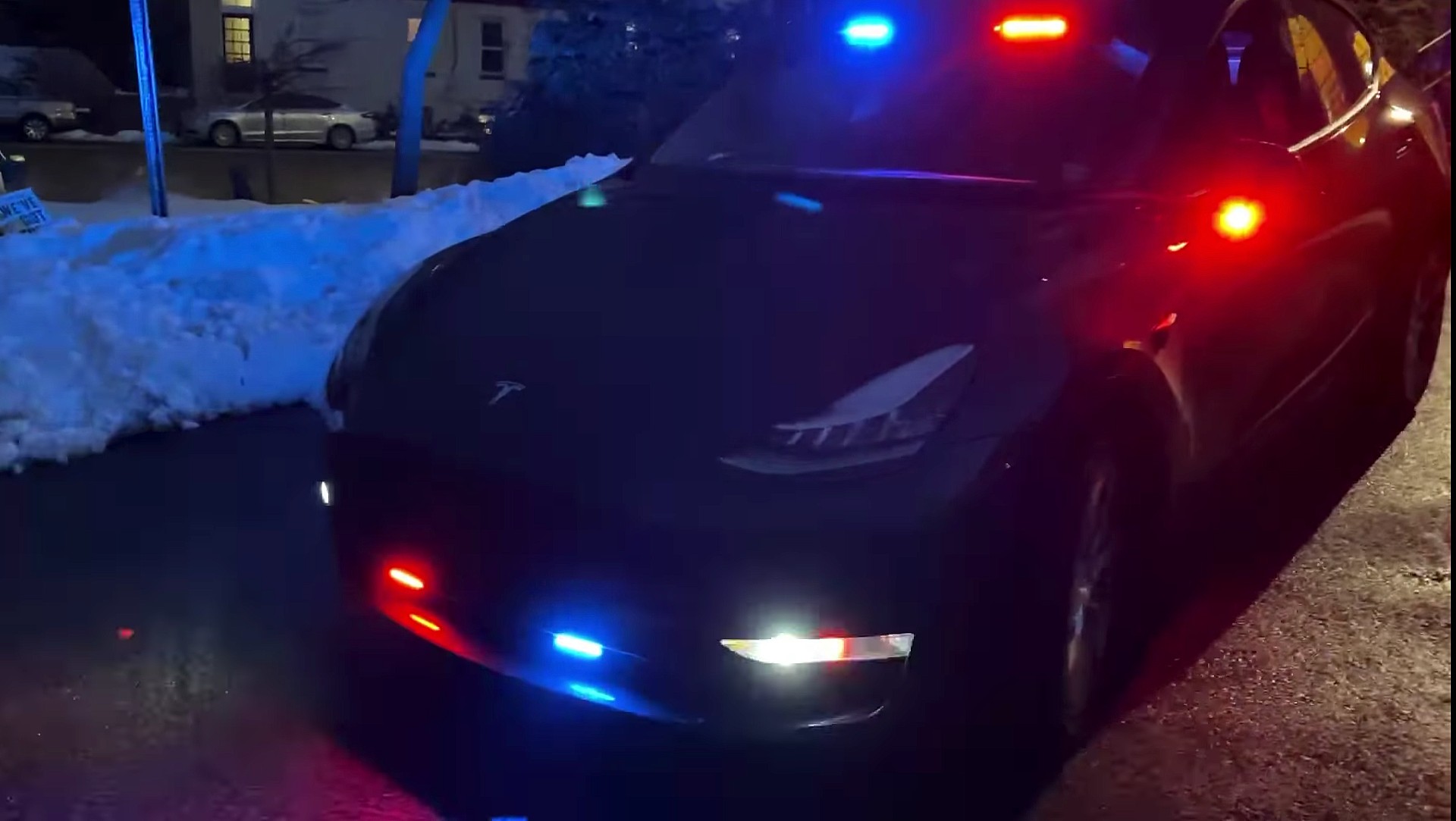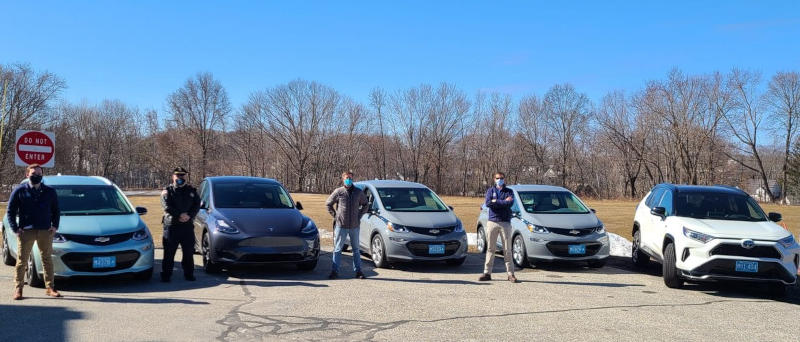

News
Tesla Model Y joins a new Police Force, and incentives made it an affordable purchase
The Tesla Model Y has officially joined the Ipswich, Massachusetts Police Department, and its price tag wasn’t all that bad considering the multiple incentives that were applied by local groups.
Teslas have become some of the newest additions to several police departments across the United States, and in some other regions of the world as well. While the environmentally-conscious vehicles will save taxpayer dollars in the long run thanks to EV credits, gas savings, and low maintenance costs, some have voiced concerns over the cost of buying a Tesla. However, many are uninformed and misconceived, still believing electric vehicles are six-figure vehicles reserved for the rich and wealthy.
In January, the Hastings on Hudson, New York Police Department welcomed a Model Y police cruiser into their fleet, only to receive several points of criticism from the purchase. Some commentors called for a defunding of the police deparment, while others said that local schools were suffering while police departments were buying “expensive” electric cars.
While the Tesla Model Y isn’t the automaker’s least expensive car, it is far from the most expensive. The Long Range All Wheel Drive variant of the all-electric crossover costs $49,990. However, several local incentives from various groups reduced the cost that would be paid with taxpayer dollars to about $39,000, a statement from Ipswich PD officials said.
A $10,000 grant from the Ipswich Electric Light Department and a $4,290 grant from the Green Community Porgram offset costs by nearly $15,000, bringing the cost down considerably at the point of purchase. Additional savings will be calculated over the life of the vehicle, as gas fill-ups, oil changes, and other points of maintenance that are present with combustion engine vehicles are inferior with the Model Y.
“The grants reduce the cost to taxpayers to about $39,000, which is comparable to gas-powered options and slightly less than the amount budgeted by the town,” the statement said.
Additionally, Ipswich PD said it will save up to $13,o00 in fuel and maintenance costs over a ten-year period.
The Model Y is not the first electric car that is involved in the Ipswich local government. It is the sixth, joining three Chevy Bolts, and a Toyota RAV4 Plug-in Hybrid, all reserved for specific individuals in the town’s local government.
Credit: Town of Ipswich
Ipswich Officials have taken other steps to reduce community fossil fuel usage in recent years. Here are a few examples according to the Ipswich Local News.
• The ELD has replaced five late-model vehicles with electric vehicles: an electric Hyster forklift for the department garage; Chevrolet Bolts for use by the department engineer, town conservation agent, and town building and health departments; and a Toyota RAV4 plug-in hybrid vehicle for the ELD manager. ELD estimates the electric vehicles have reduced operating and maintenance costs by several thousand dollars and cut gasoline usage by about 1,000 gallons.
• The town has installed electric vehicle charging stations at the parking lots on Elm Street and Hammatt Street, the town hall, and the utilities department. More charging stations are planned as funding opportunities become available.
• In February 2020, the state certified the town as a “Green Community” with the goal of reducing municipal energy use by 20 percent within five years.
• The select board and the school committee recently adopted a resolution developed by the town’s climate resiliency committee, which commits to eliminating municipal use of fossil fuels by 2040.

Elon Musk
Elon Musk and Tesla AI Director share insights after empty driver seat Robotaxi rides
The executives’ unoccupied tests hint at the rapid progress of Tesla’s unsupervised Robotaxi efforts.

Tesla CEO Elon Musk and AI Director Ashok Elluswamy celebrated Christmas Eve by sharing personal experiences with Robotaxi vehicles that had no safety monitor or occupant in the driver’s seat. Musk described the system’s “perfect driving” around Austin, while Elluswamy posted video from the back seat, calling it “an amazing experience.”
The executives’ unoccupied tests hint at the rapid progress of Tesla’s unsupervised Robotaxi efforts.
Elon and Ashok’s firsthand Robotaxi insights
Prior to Musk and the Tesla AI Director’s posts, sightings of unmanned Teslas navigating public roads were widely shared on social media. One such vehicle was spotted in Austin, Texas, which Elon Musk acknowleged by stating that “Testing is underway with no occupants in the car.”
Based on his Christmas Eve post, Musk seemed to have tested an unmanned Tesla himself. “A Tesla with no safety monitor in the car and me sitting in the passenger seat took me all around Austin on Sunday with perfect driving,” Musk wrote in his post.
Elluswamy responded with a 2-minute video showing himself in the rear of an unmanned Tesla. The video featured the vehicle’s empty front seats, as well as its smooth handling through real-world traffic. He captioned his video with the words, “It’s an amazing experience!”
Towards Unsupervised operations
During an xAI Hackathon earlier this month, Elon Musk mentioned that Tesla owed be removing Safety Monitors from its Robotaxis in Austin in just three weeks. “Unsupervised is pretty much solved at this point. So there will be Tesla Robotaxis operating in Austin with no one in them. Not even anyone in the passenger seat in about three weeks,” he said. Musk echoed similar estimates at the 2025 Annual Shareholder Meeting and the Q3 2025 earnings call.
Considering the insights that were posted Musk and Elluswamy, it does appear that Tesla is working hard towards operating its Robotaxis with no safety monitors. This is quite impressive considering that the service was launched just earlier this year.
Elon Musk
Starlink passes 9 million active customers just weeks after hitting 8 million
The milestone highlights the accelerating growth of Starlink, which has now been adding over 20,000 new users per day.

SpaceX’s Starlink satellite internet service has continued its rapid global expansion, surpassing 9 million active customers just weeks after crossing the 8 million mark.
The milestone highlights the accelerating growth of Starlink, which has now been adding over 20,000 new users per day.
9 million customers
In a post on X, SpaceX stated that Starlink now serves over 9 million active users across 155 countries, territories, and markets. The company reached 8 million customers in early November, meaning it added roughly 1 million subscribers in under seven weeks, or about 21,275 new users on average per day.
“Starlink is connecting more than 9M active customers with high-speed internet across 155 countries, territories, and many other markets,” Starlink wrote in a post on its official X account. SpaceX President Gwynne Shotwell also celebrated the milestone on X. “A huge thank you to all of our customers and congrats to the Starlink team for such an incredible product,” she wrote.
That growth rate reflects both rising demand for broadband in underserved regions and Starlink’s expanding satellite constellation, which now includes more than 9,000 low-Earth-orbit satellites designed to deliver high-speed, low-latency internet worldwide.
Starlink’s momentum
Starlink’s momentum has been building up. SpaceX reported 4.6 million Starlink customers in December 2024, followed by 7 million by August 2025, and 8 million customers in November. Independent data also suggests Starlink usage is rising sharply, with Cloudflare reporting that global web traffic from Starlink users more than doubled in 2025, as noted in an Insider report.
Starlink’s momentum is increasingly tied to SpaceX’s broader financial outlook. Elon Musk has said the satellite network is “by far” the company’s largest revenue driver, and reports suggest SpaceX may be positioning itself for an initial public offering as soon as next year, with valuations estimated as high as $1.5 trillion. Musk has also suggested in the past that Starlink could have its own IPO in the future.
News
NVIDIA Director of Robotics: Tesla FSD v14 is the first AI to pass the “Physical Turing Test”
After testing FSD v14, Fan stated that his experience with FSD felt magical at first, but it soon started to feel like a routine.

NVIDIA Director of Robotics Jim Fan has praised Tesla’s Full Self-Driving (Supervised) v14 as the first AI to pass what he described as a “Physical Turing Test.”
After testing FSD v14, Fan stated that his experience with FSD felt magical at first, but it soon started to feel like a routine. And just like smartphones today, removing it now would “actively hurt.”
Jim Fan’s hands-on FSD v14 impressions
Fan, a leading researcher in embodied AI who is currently solving Physical AI at NVIDIA and spearheading the company’s Project GR00T initiative, noted that he actually was late to the Tesla game. He was, however, one of the first to try out FSD v14.
“I was very late to own a Tesla but among the earliest to try out FSD v14. It’s perhaps the first time I experience an AI that passes the Physical Turing Test: after a long day at work, you press a button, lay back, and couldn’t tell if a neural net or a human drove you home,” Fan wrote in a post on X.
Fan added: “Despite knowing exactly how robot learning works, I still find it magical watching the steering wheel turn by itself. First it feels surreal, next it becomes routine. Then, like the smartphone, taking it away actively hurts. This is how humanity gets rewired and glued to god-like technologies.”
The Physical Turing Test
The original Turing Test was conceived by Alan Turing in 1950, and it was aimed at determining if a machine could exhibit behavior that is equivalent to or indistinguishable from a human. By focusing on text-based conversations, the original Turing Test set a high bar for natural language processing and machine learning.
This test has been passed by today’s large language models. However, the capability to converse in a humanlike manner is a completely different challenge from performing real-world problem-solving or physical interactions. Thus, Fan introduced the Physical Turing Test, which challenges AI systems to demonstrate intelligence through physical actions.
Based on Fan’s comments, Tesla has demonstrated these intelligent physical actions with FSD v14. Elon Musk agreed with the NVIDIA executive, stating in a post on X that with FSD v14, “you can sense the sentience maturing.” Musk also praised Tesla AI, calling it the best “real-world AI” today.








